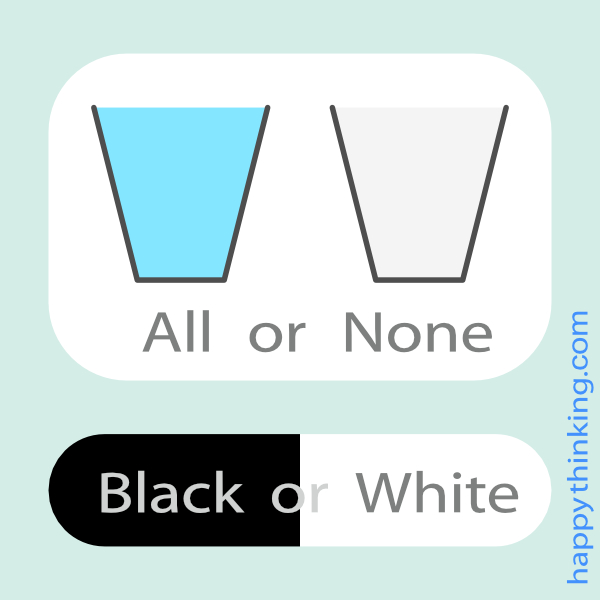The unhelpful thinking pattern that we will discuss on this page is called “all or nothing thinking” which means that one makes extreme judgments on various things, rather than making more balanced “in-between” judgments. Most things in the world around you are not “extreme”. There is a good chance that the coffee or tea that you drink at the train station every day doesn’t taste “extremely good” or “extremely bad”. Rather, it is more likely to taste somewhere in between the two extremes. Similarly, your colleagues at your workplace are probably not “extremely friendly” or “extremely unfriendly”, but more likely to be somewhere in between. Unfortunately, one may develop an unhelpful thinking pattern that involves one thinking often in extremes (e.g. that coffee is extremely good, my colleagues are extremely bad etc), rather than seeing things in a more realistic “in-between way”. Psychologists have named this unhelpful thinking pattern, “all or nothing” thinking, where the word “all” represents one extreme, and the word “nothing” represents the other extreme. Psychologists also call this kind of unhelpful thinking, “black and white” thinking, implying that one doing all-or-nothing thinking does not think in a more balanced “grey” way.

All-or-nothing thinking can make you unhappy as it can make you judge situations wrongly. The following short examples will help you to understand how it can cause harm.
Example 1
Imagine that you have a good friend called Lucy. She has been a true friend to you for many years, sharing your happiness and troubles. Lucy has always gone out of her way to be helpful to you whenever you were in need.
Let us now imagine that today is your birthday and that Lucy, perhaps because she was busy, forgot to wish you. Now let us suppose that your mind does all-or-nothing thinking. Your mind will think, “Lucy is a really terrible person who does not care about me at all. How could she forget my birthday, when she knows I like people to wish me? She is completely useless, etc.” In this scenario, “all-or-nothing thinking” is making you think only in extremes. You ignore all the good that Lucy has done over the years, and instead, let this one small error made by her, make her “all bad”.
In reality, while it was “bad” for Lucy to have forgotten your birthday, it was only one “bad” thing among the many more “good” things she has done for you over the years. So instead of seeing Lucy as “completely bad”, a better way would be to see her as being “mostly good” and only “slightly bad”. As you have seen in this example, all-or-nothing thinking can make one judge people unfairly.
Example 2
Anju goes to a restaurant and has a three-course meal. The starters taste fantastic, the main course is equally delicious, and even the dessert is super good. Then at the end, Anju orders a coffee. The waiter brings the coffee and as a special treat, also brings a biscuit to go with it. Anju finds the coffee to be excellent but unfortunately discovers that the biscuit is a little spoiled.
At this point, let’s imagine that Anju’s mind does all-or-nothing thinking. This makes her focus only on the spoilt biscuit and completely forget that the other parts of the meal were fantastic. Anju complains about the biscuit for the rest of the evening, telling everyone how the meal was completely terrible.
In this example, you can see how, because of all-or-nothing thinking, the restaurant was not judged fairly. This is not to say that the spoilt biscuit should have been ignored. Rather, it is about putting things in the correct perspective.
As you have seen in the above examples, all-or-nothing thinking distorts how things really are, and this can make one make wrong judgments. In the tools section of this website, we will talk about how to see things in a more balanced way.